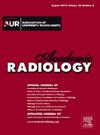Delta-radiomics Analysis Based on Multi-phase Contrast-enhanced MRI to Predict Early Recurrence in Hepatocellular Carcinoma After Percutaneous Thermal Ablation
IF 3.8
2区 医学
Q1 RADIOLOGY, NUCLEAR MEDICINE & MEDICAL IMAGING
引用次数: 0
Abstract
Rationale and Objectives
It is critical to predict early recurrence (ER) after percutaneous thermal ablation (PTA) for hepatocellular carcinoma (HCC). We aimed to develop and validate a delta-radiomics nomogram based on multi-phase contrast-enhanced magnetic resonance imaging (MRI) to preoperatively predict ER of HCC after PTA.
Materials and Methods
We retrospectively enrolled 164 patients with HCC and divided them into training, temporal validation, and other-scanner validation cohorts (n = 110, 29, and 25, respectively). The volumes of interest of the intratumoral and/or peritumoral regions were delineated on preoperative multi-phase MR images. Original radiomics features were extracted from each phase, and delta-radiomics features were calculated. Logistic regression was used to train the corresponding radiomics models. The clinical and radiological characteristics were evaluated and combined to establish a clinical-radiological model. A fusion model comprising the best radiomics scores and clinical-radiological risk factors was constructed and presented as a nomogram. The performance of each model was evaluated and recurrence-free survival (RFS) was assessed.
Results
Child-Pugh grade B, high-risk tumor location, and an incomplete/absent tumor capsule were independent predictors of ER. The optimal radiomics model comprised 12 delta-radiomics features with areas under the curve (AUCs) of 0.834, 0.795, and 0.769 in the training, temporal validation, and other-scanner validation cohorts, respectively. The nomogram showed the best predictive performance with AUCs as 0.893, 0.854, and 0.827 in the three datasets. There was a statistically significant difference in RFS between the risk groups calculated using the delta-radiomics model and nomogram.
Conclusions
The nomogram combined with the delta-radiomic score and clinical-radiological risk factors could non-invasively predict ER of HCC after PTA.
基于多相对比增强磁共振成像的德尔塔放射组学分析预测经皮热消融术后肝细胞癌的早期复发
理由和目标:预测肝细胞癌(HCC)经皮热消融(PTA)术后早期复发(ER)至关重要。我们旨在开发并验证一种基于多相对比增强磁共振成像(MRI)的δ-放射组学提名图,用于术前预测肝细胞癌经皮热消融术(PTA)后的早期复发:我们回顾性地纳入了 164 例 HCC 患者,并将其分为训练队列、时间验证队列和其他扫描仪验证队列(n = 110、29 和 25)。在术前多相位磁共振图像上划定瘤内和/或瘤周区域的感兴趣体积。从每个相位提取原始放射组学特征,并计算δ放射组学特征。使用逻辑回归来训练相应的放射组学模型。对临床和放射学特征进行评估和组合,以建立临床放射学模型。由最佳放射组学评分和临床放射学风险因素组成的融合模型被建立起来,并以提名图的形式呈现。对每个模型的性能进行了评估,并对无复发生存率(RFS)进行了评估:结果:Child-Pugh B级、高危肿瘤位置和肿瘤包膜不完整/缺失是ER的独立预测因素。最佳放射组学模型由12个δ-放射组学特征组成,在训练组、时间验证组和其他扫描仪验证组中的曲线下面积(AUC)分别为0.834、0.795和0.769。在三个数据集中,提名图的预测性能最好,AUC 分别为 0.893、0.854 和 0.827。使用德尔塔放射组学模型和提名图计算的风险组之间的RFS差异具有统计学意义:提名图结合δ-放射组学评分和临床放射学风险因素可以无创预测PTA后HCC的ER。
本文章由计算机程序翻译,如有差异,请以英文原文为准。
求助全文
约1分钟内获得全文
求助全文
来源期刊

Academic Radiology
医学-核医学
CiteScore
7.60
自引率
10.40%
发文量
432
审稿时长
18 days
期刊介绍:
Academic Radiology publishes original reports of clinical and laboratory investigations in diagnostic imaging, the diagnostic use of radioactive isotopes, computed tomography, positron emission tomography, magnetic resonance imaging, ultrasound, digital subtraction angiography, image-guided interventions and related techniques. It also includes brief technical reports describing original observations, techniques, and instrumental developments; state-of-the-art reports on clinical issues, new technology and other topics of current medical importance; meta-analyses; scientific studies and opinions on radiologic education; and letters to the Editor.
 求助内容:
求助内容: 应助结果提醒方式:
应助结果提醒方式:


